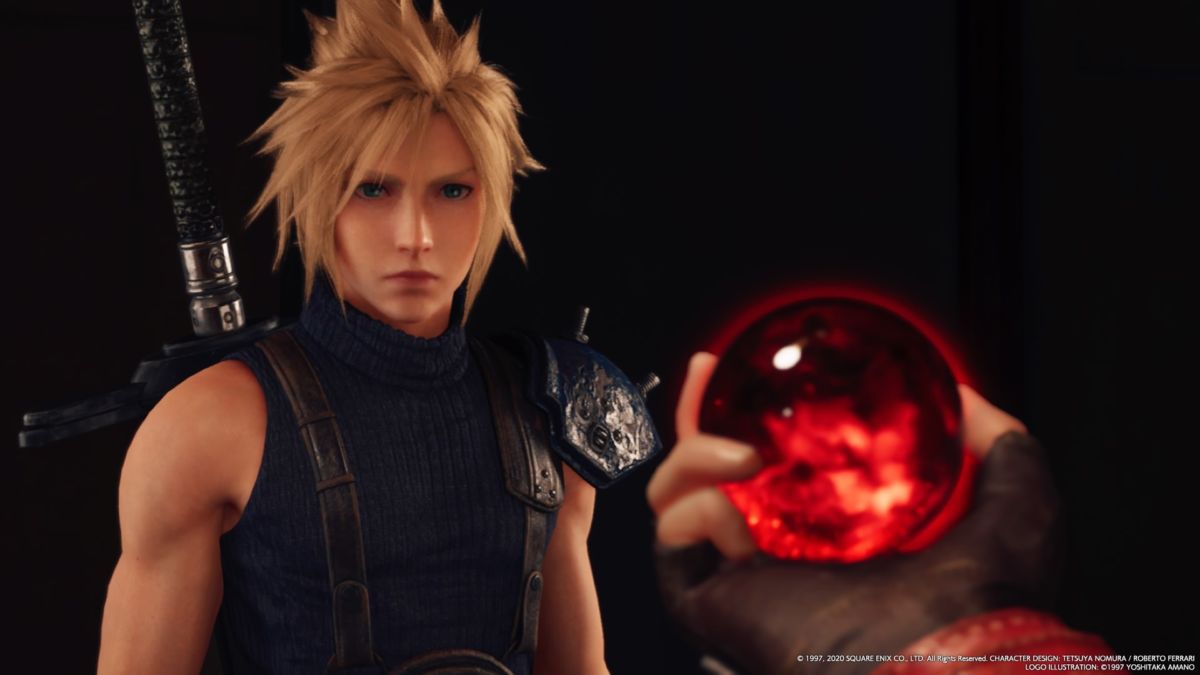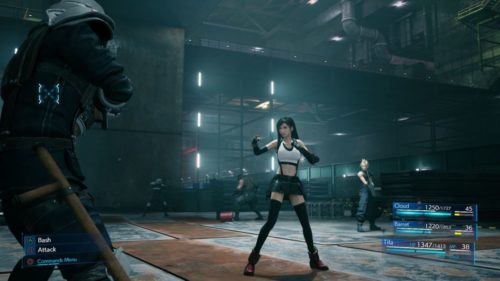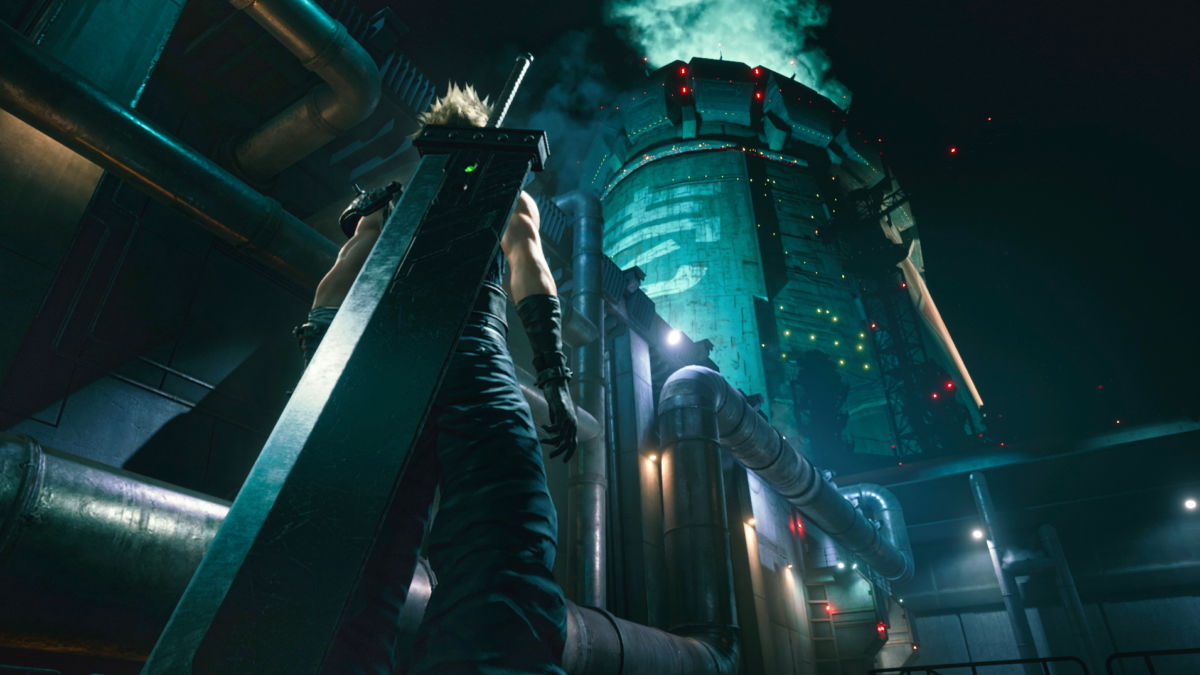Final Fantasy VII lives high in the annals of video game legend. Like Super Mario 64 and The Legend of Zelda: Ocarina of Time, Final Fantasy VII managed to bring the format of its series into the daunting expanses of the third dimension with rousing success. Holding such a mythical, admirable place in the realm of gaming makes it a tough act to follow for any remake. Luckily Final Fantasy VII Remake isn’t just any remake — it’s among the best we’ve ever seen.
Right from the start, Final Fantasy VII Remake walks a knife’s edge that teeters back and forth between nostalgia and new content. Take the opening bombing run on the Midgar reactor. The prelude and the panning shot that hovers over Midgar cuts with the roaring of the train that Avalanche is using to break into the reactor, just like in the original. However, with all the new dialogue and character depth added to side characters like Wedge, Biggs and Jessie, as the mission continues, it becomes immediately clear that this return to Midgar is going big on expansion.

Much of this might be obvious to those of you who have been following each press release, trailer and interview that has been trickling out steadily over the last couple of years. For the rest of us, though, those who have tried to stay in the dark as much as possible, this will come as a glorious relief.
Rather than leaning all in on the buckets of goodwill and memories that many older players will have for the original, Final Fantasy VII Remake ebbs and flows between sprinkling it around as an occasional reward and diving headlong into completely new story beats.

The stars of these expanded sections are obviously the side characters and new characters, both of whom get a surprising amount of screen time here, but even the main cast is given a much richer backstory and character context in terms of how this adventure unfolds. By the end, fans will no doubt be on Square Enix and director Tetsuya Nomura’s side of things in regard to these changes as they easily make the world feel more intricate and nuanced.
The classic tale of a band of eco-terrorists trying to overthrow energy giant Shinra, whose energy source is literally the lifeblood of the planet, has never been more prescient. As central protagonist Cloud Strife battles his own inner demons,illustrious past, and cynical disposition, he undergoes one of the most fantastic character arcs in RPG history. The other team members introduced here (Tifa, Barret, Aerith, and a smatter of Red XIII) also have thrilling additions to their stories and motivations over the course of the journey, and, of course, legendary villains like Sephiroth and the Turks get more screen time as well.

These new bits of characterization are boosted considerably by the stellar voice acting of the cast. John Eric Bentley’s Barret is spot on with how fans would imagine this character, while Britt Baron’s Tifa and Briana White’s Aerith are both oozing with personality here. Another stand out is Erica Lindbeck’s take on Jessie, which turns barely there side character from the original game into one of the most memorable parts of the journey.
This is without even touching on the music. Gorgeously redone orchestral and electric renderings of Nobuo Uematsu’s classic FFVII score offer wonderfully reimagined takes with just enough of the original in their structure to stir memories of 1997 all over again. The fresh take on the main boss battle theme, which plays during many an epic struggle, is a particular standout. Aerith’s theme and the Sector 6 music will also kindle fond old feelings, while also changing just enough to feel worth the effort.

The visuals, too, are an absolute feast for the senses. Tetsuya Nomura’s fantastic character design has been lovingly transferred to our more modern sensibilities with only the smallest of changes made to adapt these characters to a more realistic standard.
The expansive depths and heights of Midgar have also been gorgeously expanded upon. The first time Final Fantasy VII Remake lets you run free in the Sector 7 slums, players will be blown away by how big the area has become and how much there is to see and do there. This early experience is indicative of how the whole remake offers a richer, more rewarding experience for not just series stalwarts but first-time dabblers as well.

Generally the game flows really well, keeping things moving while allowing players some wiggle room to explore. However, there are a couple of sections that lag on a bit, particularly the maze-like jaunt into the second reactor. While the effort of the expansion in areas like this is appreciated, they can be a bit too lengthy at times.
In the side quest department, the dart minigame is surprisingly in depth and fun, more reminiscent of a sniper style challenge than a bit of backroom twaddle. The motorcycle arcade game from the original game makes something of a return here as well, with a replayable gameplay section allowing players to really impress Jessie and co. with their Road Rash skills. Finally, a young Shinra employee encourages the player to collect battle data throughout the game, making for a knockout sidequest that nets plenty of useful materia.
Moving along to the nuts and bolts of the experience, Final Fantasy VII Remake most closely resembles Final Fantasy XV in the gameplay department. The battle system is like a spruced up version of that entry with classic touches from FFVII, the stagger system from FFXIII, and a few new additions spritzed about.
Expect the general flow of combat to feel like FFXV with a few more coats of polish. Players will start battles off with basic attacks that fill up the classic ATB gauge of older Final Fantasy titles. As these gauges fill up, more attacks become available, as well as the abilities to use spells or items.

More intense battles will call for a bit of strategy to overcome. Limit breaks, summons, and of course, materia, are all essential elements of mastering the battle system and its many quirks. While Cloud has the beefiest arsenal of moves, with two signature battle styles available from the jump, someone like Tifa is often your best bet to fill up the stagger gauge, allowing you to do some real damage to your foes.
Classic moves also make a return here, with the more advanced attack options and limit breaks taking clear inspiration from the original game, albeit with a bit more pizzazz than the PS1 was obviously capable of. This will leave long time fans of the game wondering how epic endgame attacks like Omnislash or Knights of the Round will be rendered in future installments.

Real purists even have the option of switching the battle style to Classic, a mode that allows for the closest amalgamation of the original FFVII experience while still allowing for the bells and whistles of this reimagining. While it might be a bit too slow-paced for your modern action-RPG fan (I much prefer the fast, frenetic default experience), the addition is still a welcome concession to fans of old school JRPGs.
Switching back and forth between characters in battle is fast and intuitive, and each character really does have their own strengths. Barret with his long range gun attacks is the most obvious example, but Tifa and Aerith are no slouches either, particularly Aerith, whose attack power has been amped up considerably from the original Final Fantasy VII.

Speaking of amped up, the boss battles are also massively expanded this time around. Final Fantasy VII Remake offers some of the most epic boss battles in the franchise, with some of them coming much earlier than expected. For those of you who have played the demo, expect many bosses like the Guard Scorpion to be scaled up in ways you never could have imagined.
The Airbuster, in particular, is no pushover this time around. In fact, many re-imagined bosses and enemies will give you a run for your gil if you’re not taking them seriously. Final Fantasy VII Remake breaks you in softly to start with but it isn’t long before it starts kicking the challenge into high gear, especially if you keep the game on the default Normal difficulty.

As many have speculated, this section of the story balances the small slice of the original that it covers here by diving very deep into the backstory of its central characters. Much of the narrative work that was done later in the original game is covered during the Midgar section, making it so this doesn’t just feel like 5 hours of story stretched into a full game. The changes help to justify the fact that this entire entry is set in Midgar, while laying enough groundwork so that the remaining entries ought to flow much more smoothly.
Finally, the experience is rounded out with a whack of extra content to give players more bang for their buck. Tons of minigames, side quests and optional content pepper the 30-50 hour campaign. Better still, more dedicated players will have the opportunity to come back to these later if they so choose, as every chapter is replayable once you reach the endgame.

For trophy hunters, this makes going for that platinum in Final Fantasy VII Remake much more manageable, while more casual players will be able to take the game at whatever pace they see fit. Again, this game handily nails the balance between all players, old and new, casual and hardcore, nostalgics and newbies.
In the end, Final Fantasy VII Remake stands tall with last year’s Resident Evil 2 remake as the ultimate gold standard for what fans will want and expect from future remakes to come. It also lays a thrilling groundwork for the remaining games in this project. Establishing the foundation for what could be the most beloved run of games in the series, Final Fantasy VII Remake is a triumph of a game, and a thrill of an experience. The remaining entries in this reimagining of one of the most legendary games of all time cannot come soon enough.
A PS4 key was provided by PR for the purposes of this review
Some of the coverage you find on Cultured Vultures contains affiliate links, which provide us with small commissions based on purchases made from visiting our site. We cover gaming news, movie reviews, wrestling and much more.






